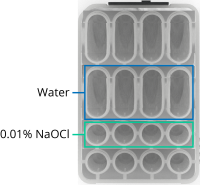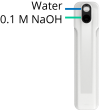The difference is that a maintenance wash uses an NaOH solution in certain rows (see below), while a maintenance rinse uses water in those rows. The washes and rinses are also done at different intervals.
When to Perform a Maintenance Wash or Rinse
Perform maintenance washes and rinses for all positions at the following occasions:
Occasion
Action
2 weeks after last maintenance wash or rinse
Maintenance wash or rinse
2 months after last maintenance wash
Maintenance wash
Position has been idle for 1 week or more
Maintenance wash
Instrument or position will be idle for 1 week to 1 month
Maintenance rinse after the last run before the idle period
and
Maintenance wash before the first run after the idle period
Instrument or position will be idle for more than 1 month
Contact How Do I Contact Customer Care? to schedule a service appointment for draining your system
Instrument or position will be idle for 1 week or more after a maintenance wash
Maintenance rinse
You can also initiate a manual maintenance wash or rinse outside these intervals, for example, to clear the lines of the instrument of salt accumulation.
Consumables & Equipment
• Milli-Q water (or better).
• Reagent-grade (or better) 5% sodium hypochlorite (NaOCl), for example: https://www.sigmaaldrich.com/US/en/product/sigald/239305.
• Maintenance wash only: 1 M NaOH stock solution.
• G4 Maintenance Kit (part number 700,002), which has the following components:
Item
Description
Quantity
Maintenance Sample Cartridge
G4 empty sample cartridge (reusable)
4
Maintenance Reagent Cartridge
G4 empty maintenance reagent cartridge (reusable)
4
Maintenance Wash Cartridge
G4 empty wash cartridge (reusable)
4
Maintenance Flow Cell
G4 maintenance flow cell (reusable)
4
• Instead of the Maintenance Flow Cell, you can also use a regular used flow cell for each position that needs a maintenance wash or rinse.
Performing a Maintenance Wash or Rinse
If you want to initiate a maintenance wash or rinse from the ICS prompt, do the following :
1. For each position you want to wash or rinse, make fresh:
- a. 2 mL 0.01% sodium hypochlorite by diluting sodium hypochlorite stock solution in water.
- b. Maintenance wash only: 200 mL 0.1 M NaOH by diluting 20 mL of 1 M NaOH stock solution in 180 mL water.
If you are washing or rinsing multiple positions, multiply volumes by the number of positions.
2. Rinse all wells of the maintenance cartridges with water to remove any dust or particulates that may have accumulated in the cartridges.
3. Fill the maintenance cartridges with the following reagents:
Note
The Maintenance Reagent Cartridge has lower and upper fill guides in every well. As long as you fill the well above the lower fill guide and below the upper fill guide, there is enough volume for the maintenance wash or rinse.
Cartridge
Location
(counted from top of picture)
Wash or Rinse Reagents
Volume
Image
Maintenance
Reagent
Cartridge
Rows 2, 4, 6, 8, 10
Rows marked 1
Water
In between fill guides
(25 mL)

Rows 1, 3, 5, 7, 9, 11
Rows marked 2
Wash: 0.1 M NaOH
Rinse: Water
In between fill guides
(15 mL)
Row 12
Row marked 1
Water
In between fill guides
(75 mL)
Maintenance
Sample
Cartridge
All wells in row 2
Water
1.2 mL per well

All wells in row 3
0.01% sodium hypochlorite
0.4 mL per well
Maintenance
Wash
Cartridge
Top (bulk) compartment
Water
200 mL

Small rinse well
Wash: 0.1 M NaOH
Rinse: Water
9 mL
4. Start the wash protocol one of these two ways:
• Select the Start Wash in the ICS prompt.
• Go to the Instrument | Maintenance section in the Instrument Control Software and select Wash.
5. Unselect the positions you do not want to wash or rinse (see Figure 1). By default all positions are selected.

Figure 1 Confirming maintenance wash positions with positions 1, 3, and 4 selected, and position 2 unselected.
6. Load the consumables as prompted.
WARNING
The flow cell stage may still be hot from the previous run. Be careful not to injure your hands.
The reagent sippers are sharp. Be careful not to touch as you can injure your hands.
CAUTION
Be careful when loading consumables to avoid spilling, because the cartridges are not sealed. If you do spill buffer, promptly clean up with a dry low-particulate wipe before proceeding the maintenance wash or rinse.
Make sure to always wear gloves when handling reagents, waste, or spills.
WARNING
Waste contains formamide, a suspected carcinogen and reproductive toxin, and other potentially hazardous chemicals. Personal injury can occur through inhalation, ingestion, skin contact, and eye contact. Wear protective equipment, including eye protection, gloves, and laboratory coat appropriate for risk of exposure. Handle used reagents as chemical waste and discard in accordance with applicable regional, national, and local laws and regulations through a licensed hazardous waste contractor.
7. Follow the instructions in the Instrument Control Software. For an explanation of the flow cell position light colors, see What Do The Flow Cell Compartment Lights Mean?
8. If you performed a maintenance wash and the instrument or position will not be used for 1 week or more, perform a maintenance rinse.
9. After the maintenance wash or rinse has finished, rinse all maintenance cartridges the following way:
- a. Rinse all wells in the maintenance cartridges with Milli-Q water. Make sure no NaOH or sodium hypochlorite remains in the wells.
- b. Put the maintenance cartridges upside down and let dry in the air.
- c. Store the maintenance cartridges in a closed dust free box when dry and not in use.
CAUTION
Failure to clean and correctly store maintenance cartridges can result in fluidic system damage to the Instrument.
